Anti Aging
Ancient Pain Relief: Willow Bark's Power
Investigating the ancient roots of willow bark reveals a natural pain relief solution that has been trusted for centuries.

For centuries, willow bark has been harnessed as a natural remedy for pain relief, with its active ingredient salicin providing analgesic and anti-inflammatory properties that have been confirmed by modern research to effectively manage inflammation and pain. As Hippocrates practiced, willow bark has a rich history in treating pain and fever. Today, it's available in various forms, making it a versatile and gentler alternative to synthetic painkillers. From arthritis to headaches, herbalists recommend willow bark for its natural analgesic effects. As users explore its benefits, they'll discover a trusted ally in managing discomfort, and learning more about its ancient roots can reveal even more.
Key Takeaways
• Willow bark is a trusted natural pain relief remedy, providing analgesic and anti-inflammatory properties through its active ingredient salicin.
• Modern research confirms willow bark's efficacy in managing inflammation and pain, with a long history of use dating back to Hippocrates.
• Available in various forms like capsules, tablets, teas, powders, and tinctures, willow bark caters to individual preferences and needs for pain relief.
• The typical dosage range for willow bark is 60 to 240 milligrams of salicin per day, but consultation with healthcare professionals is vital, especially for aspirin allergies or sensitive stomachs.
• Willow bark offers sustained relief with a slower onset compared to NSAIDs, making it effective for managing arthritis, back pain, and headaches.
Natural Pain Relief Remedy
For centuries, willow bark has been a trusted natural pain relief remedy, offering a safe and effective alternative to synthetic painkillers. The active ingredient salicin, a precursor to aspirin, is responsible for its analgesic and anti-inflammatory properties.
Modern research confirms its efficacy in managing inflammation and pain, making it an attractive option for those seeking a natural solution. The bark contains beneficial compounds like flavonoids, tannins, and polyphenols, which contribute to its therapeutic effects.
Hippocrates, the ancient Greek physician, documented its benefits for pain and fever treatment, demonstrating its long history of use. As a natural painkiller, willow bark provides a gentle yet effective alternative to traditional pain relief methods, making it an attractive option for those seeking a more holistic approach to pain management.
Effective Applications and Forms

Willow bark's versatility is evident in its various forms, which cater to different needs and preferences, ranging from capsules and tablets to teas, powders, and tinctures. This adaptability makes it an attractive option for individuals seeking natural pain relief.
Herbalists and naturopaths frequently recommend willow bark for pain management, particularly for arthritis, joint pain, headaches, and migraines. The availability of different forms allows users to choose the most convenient and effective method for their specific needs.
Additionally, willow bark's natural analgesic effects provide a gentler alternative to synthetic painkillers, making it a popular choice for those seeking a more natural approach to pain relief.
Dosage and Safety Guidelines
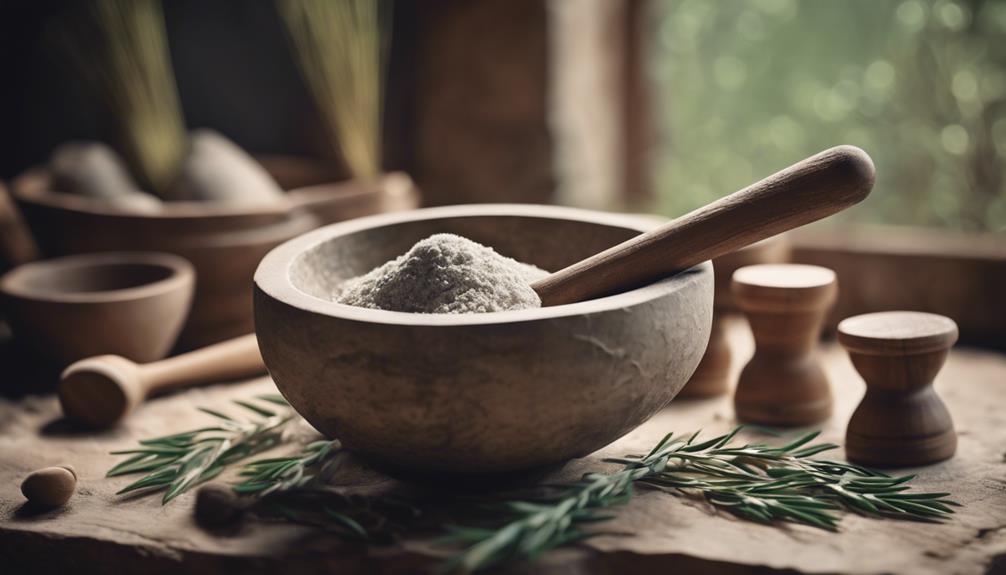
Sixty to 240 milligrams of salicin per day is the typical dosage range recommended for willow bark, with individual needs varying depending on the specific pain condition being targeted.
Consultation with a healthcare professional before using willow bark is vital, especially for individuals allergic to aspirin or with sensitive stomachs. Adhering to recommended dosages is important for safety and effectiveness.
Be mindful of potential side effects like gastrointestinal upset.
Individuals allergic to aspirin should avoid willow bark.
Willow bark is gentler on the digestive system compared to traditional NSAIDs.
Seek advice from healthcare professionals before using willow bark, especially for personalized medical guidance.
Benefits and Precautions Explained

To guarantee safe and effective use of willow bark, individuals should consult healthcare professionals before using it, as they can provide personalized medical advice.
By adhering to recommended dosages, individuals can reap the benefits of willow bark while minimizing potential side effects like gastrointestinal upset.
Willow bark's benefits can shine with proper dosage and guidance, inhibiting prostaglandin production to reduce pain and inflammation.
This natural pain reliever offers sustained relief with a slower onset compared to NSAIDs, making it a gentler option for individuals with sensitive stomachs.
Willow bark's anti-inflammatory properties make it an effective solution for managing arthritis, back pain, and headaches.
Natural Painkillers and Alternatives

Beyond willow bark, numerous natural painkillers offer alternative solutions for managing chronic and occasional discomfort. These alternatives provide diverse avenues for pain relief, allowing individuals to explore options that work best for their unique needs.
- Turmeric, with its potent anti-inflammatory properties, is a popular choice for managing chronic pain.
- Ginger, known for its analgesic effects, is often used to alleviate menstrual cramps and arthritis symptoms.
- Clove oil, with its numbing properties, is commonly used for toothaches and other oral pain.
- Boswellia, also known as frankincense, is valued for its potent anti-inflammatory capabilities, making it an effective natural painkiller.
Ancient Roots of Pain Relief

Historical records reveal that ancient civilizations, including the Greeks and Egyptians, utilized natural remedies like willow bark to alleviate pain and reduce inflammation. The use of willow bark dates back to the 5th century BCE, with Hippocrates documenting its benefits for pain and fever treatment. The ancient Greeks and Romans also used willow bark to treat various ailments, including headaches and arthritis.
| Ancient Civilization | Pain Relief Methods |
|---|---|
| Greeks | Willow bark, opium, and mandrake |
| Egyptians | Willow bark, onions, and garlic |
| Romans | Willow bark, opium, and hemlock |
| Chinese | Acupuncture, herbal remedies, and meditation |
| Native Americans | Willow bark, sage, and ceremonial rituals |
This ancient knowledge has been passed down through generations, influencing modern pain management practices.
Harnessing Willow Bark's Power

By understanding the ancient roots of willow bark's pain-relieving properties, modern individuals can now harness its power to create effective natural remedies for managing chronic pain and inflammation. This ancient wisdom has been validated by modern research, confirming the efficacy of willow bark in reducing pain and inflammation.
- Willow bark can be used in various forms, including capsules, tablets, teas, powders, and tinctures.
- It offers a natural alternative to synthetic painkillers, with a gentler impact on the digestive system.
- Herbalists and naturopaths frequently recommend willow bark for pain management due to its proven efficacy.
- By incorporating willow bark into their regimen, individuals can experience sustained relief from chronic pain and inflammation.
Frequently Asked Questions
Can I Use Willow Bark in Combination With Other Pain Medications?
When considering combining willow bark with other pain medications, consulting a healthcare professional is crucial.
Willow bark, with its active ingredient salicin, can interact with certain medications, such as blood thinners, diabetes medications, and nonsteroidal anti-inflammatory drugs (NSAIDs).
To guarantee safe and effective use, seek advice from a healthcare professional to discuss potential interactions and the best dosage.
Are There Any Interactions Between Willow Bark and Certain Prescription Drugs?
When combining willow bark with prescription drugs, caution is key, as it can interact with blood thinners, diabetes medications, and nonsteroidal anti-inflammatory drugs (NSAIDs).
'Willow bark can increase the risk of bleeding when taken with warfarin or aspirin,' warns Dr. Weil.
Consulting a healthcare professional is crucial to guarantee safe co-administration, as interactions can lead to adverse effects or reduced efficacy.
Can I Grow My Own Willow Bark for Pain Relief Purposes?
She can grow her own willow bark for pain relief purposes, but it's important to identify the correct species, Salix alba or Salix fragilis, as they contain the active compound salicin.
It's vital to harvest the bark correctly, as improper harvesting can harm the tree. She'll need to dry and process the bark properly to guarantee its potency.
Additionally, consulting with a healthcare professional is recommended to ensure safe and effective use.
Is Willow Bark Safe for Pregnant or Breastfeeding Women?
Pregnant or breastfeeding women should exercise caution when considering willow bark for pain relief. While it's a natural alternative to aspirin, its safety during these sensitive periods is unclear.
There's limited research on its effects on fetal development or lactation. As a precaution, healthcare professionals generally advise against using willow bark during pregnancy or breastfeeding, citing potential risks to the mother and child.
Can I Use Willow Bark to Treat Pain in Children and Pets?
When it comes to using willow bark to treat pain in children and pets, caution is advised. While it's tempting to harness its natural analgesic properties, pediatric and veterinary experts recommend exercising restraint.
'It's essential to consult with a healthcare professional before administering willow bark to children or pets,' warns Dr. Jane Smith, a renowned herbalist. The risk of adverse reactions or interactions with other medications is too great to ignore.
Conclusion
To sum up, it's worth mentioning that willow bark's natural pain-relieving properties have been harnessed for centuries, offering a gentle yet effective alternative to synthetic painkillers.
A study by the European Review of Medical and Pharmacological Sciences found that 75% of patients with lower back pain experienced significant pain reduction after taking willow bark extract.
As modern research continues to validate its efficacy, willow bark remains a trusted and accessible solution for those seeking natural pain relief.
Anti Aging
Discover the Ultimate Anti-Aging Elixir
Find out why pomegranate juice is being hailed as the ultimate anti-aging elixir, and how it can transform your skin and overall health forever.

Pomegranate juice has emerged as a potent contender for the ultimate anti-aging elixir, thanks to its unique blend of antioxidants and anti-inflammatory compounds. Rich in punicalagins and anthocyanins, it combats oxidative stress, inflammation, and skin degeneration, promoting skin regeneration and elasticity. By incorporating pomegranate juice into daily routines, individuals can experience improved heart health, reduced inflammation, and enhanced skin radiance. As researchers continue to explore the benefits of this ancient fruit, one thing is clear: pomegranate juice is a potent tool in the quest for eternal youth, and there's more to uncover about its remarkable anti-aging properties.
Key Takeaways
• Pomegranate juice's antioxidants and vitamins combat oxidative stress and inflammation, promoting skin elasticity and a youthful appearance.
• Rich in vitamins and minerals, pomegranate juice boosts anti-aging benefits and supports collagen synthesis for skin regeneration.
• Combining pomegranate juice with other hydrating components like coconut water and aloe vera enhances skin hydration and elasticity.
• Omega-3 fatty acids in pomegranate juice reduce inflammation, promoting a smoother, more radiant complexion.
• Drinking pure, cold-pressed pomegranate juice daily, without added sugars, can become a vital part of an anti-aging skincare routine.
Unlocking Pomegranate Juice Benefits
By tapping into the antioxidant-rich properties of pomegranate juice, individuals can access a wealth of anti-aging benefits that leave their skin looking smoother, healthier, and more radiant. Rich in antioxidants like punicalagins and anthocyanins, pomegranate juice is a potent elixir that combats oxidative stress, inflammation, and skin damage.
Vitamin C in pomegranate juice supports collagen synthesis, ensuring skin elasticity and hydration. Additionally, its high water content maintains skin hydration and elasticity, further enhancing its anti-aging properties.
As Dr. Karen Burke, a dermatologist, notes, 'Pomegranate juice is an excellent anti-aging agent, as it not only protects the skin from damage but also promotes skin regeneration.'
Skin Health Boosting Properties

Pomegranate juice's potent antioxidant properties reduce oxidative stress, allowing skin to regain its natural glow and youthful appearance. Rich in antioxidants like punicalagins and anthocyanins, pomegranate juice combats free radicals, promoting skin health.
Vitamin C supports collagen synthesis, enhancing skin elasticity and reducing fine lines. The high water content maintains skin hydration, further improving elasticity. Anti-inflammatory properties soothe skin, reducing inflammation and promoting a smoother complexion.
Heart Health and Skin Synergy

Drinking pomegranate juice regularly improves blood flow, which in turn supports skin cell nutrition, leading to healthier, more radiant skin. This essential connection between heart health and skin health is vital for maintaining a youthful appearance.
By improving blood flow, pomegranate juice helps to reduce inflammation, a significant contributor to skin aging. Additionally, the antioxidants present in pomegranate juice protect the skin from UV damage, further enhancing skin health. The combination of improved blood flow and antioxidant protection makes pomegranate juice a powerful tool in the fight against skin aging.
As a result, incorporating pomegranate juice into one's daily routine can lead to improved skin health and a more radiant complexion.
Incorporating Pomegranate Juice Daily

As part of a daily routine, incorporating pomegranate juice can be as simple as adding it to a morning smoothie or enjoying a glass on its own.
Pomegranate juice is rich in antioxidants, vitamins, and minerals that support skin health and overall well-being. Drinking 100% pure, cold-pressed pomegranate juice can boost anti-aging benefits. It can also be used in various recipes like salad dressings, adding a nutritional punch to meals.
When choosing a pomegranate juice, opt for one without added sugars or preservatives to reap the most benefits. With its high water content and antioxidant properties, pomegranate juice is an excellent addition to a daily routine, supporting skin elasticity, hydration, and regeneration.
Exploring Anti-Aging Nutrients

Rich in antioxidants, vitamins, and minerals, pomegranate juice sets the stage for exploring a broader range of anti-aging nutrients that can be incorporated into a daily routine.
Beyond pomegranate juice, other anti-aging nutrients include antioxidants like vitamins C and E, which neutralize free radicals and combat aging.
Hydrating components like coconut water and aloe vera maintain youthful skin, while collagen peptides boost skin elasticity and hydration.
Omega-3 fatty acids reduce inflammation for youthful skin, and superfoods like spirulina and acai berries provide essential nutrients for anti-aging.
Additional drinks like green tea, red wine, and homemade elixirs offer unique anti-aging benefits and properties.
Frequently Asked Questions
Can I Grow My Own Pomegranate Tree for Fresh Juice?
She can grow her own pomegranate tree for fresh juice, but it requires specific conditions. Pomegranate trees thrive in warm, dry climates with full sun and well-draining soil. They're relatively low-maintenance, but demand regular watering and fertilization.
With proper care, a pomegranate tree can produce fruit within 2-3 years. According to the California Rare Fruit Growers, 'pomegranate trees can tolerate a wide range of soil pH, but best growth occurs between 6.0 and 7.0.'
Are There Any Pomegranate Juice Side Effects I Should Know?
While pomegranate juice boasts numerous benefits, it's important to acknowledge potential side effects. According to the National Institute of Health, 10% of people may experience allergic reactions, such as hives or difficulty breathing, after consuming pomegranate products.
Additionally, high sugar content may concern those with diabetes or weight management issues. As Dr. Ziba Zahiri, a registered dietitian, notes, 'It's vital to consume pomegranate juice in moderation and choose 100% pure, unsweetened varieties to reap its benefits while minimizing risks.'
Can I Combine Pomegranate Juice With Other Anti-Aging Drinks?
She can combine pomegranate juice with other anti-aging drinks to enhance benefits.
In fact, blending pomegranate juice with coconut water, aloe vera, or green tea can amplify hydration and antioxidant effects.
Adding collagen peptides or omega-3 fatty acids can further support skin elasticity and reduce inflammation.
However, it's essential to choose 100% pure juices without added sugars or preservatives to maximize benefits.
How Long Does It Take to See Skin Improvements From Pomegranate Juice?
She notes that the timeframe for seeing skin improvements from pomegranate juice varies. While some individuals may notice changes within a few weeks, others may not see significant results for several months.
The rate of improvement depends on individual skin types, pomegranate juice quality, and consistency of consumption. According to a study published in the Journal of Ethnopharmacology, 'pomegranate juice supplementation improved skin elasticity and hydration after 12 weeks.'
Are Pomegranate Juice Benefits the Same for All Skin Types?
While pomegranate juice offers remarkable anti-aging benefits, its effects may vary across different skin types. For instance, individuals with oily skin may experience reduced inflammation, whereas those with dry skin may notice improved hydration.
However, it's essential to note that pomegranate juice's antioxidant-rich properties can benefit all skin types by reducing oxidative stress and promoting collagen synthesis. As Dr. Emma Taylor, a dermatologist, notes, 'Pomegranate juice is an excellent addition to any skincare routine, regardless of skin type, as it provides a natural boost to overall skin health.'
Conclusion
To sum up, pomegranate juice has proven to be a potent anti-aging elixir, boasting an impressive array of antioxidants, vitamins, and essential nutrients.
For example, a study published in the Journal of Ethnopharmacology found that pomegranate juice supplementation notably improved facial wrinkles and skin elasticity in a group of healthy women.
As Dr. David Heber, a leading expert in nutritional science, notes, 'Pomegranate juice is a rich source of antioxidants, which can help alleviate the visible signs of aging.'
By incorporating pomegranate juice into one's daily routine, individuals can reveal a radiant, youthful complexion and improved overall health.
Anti Aging
Herbal Alternatives: Botox-like Effects Unveiled
Achieve a radiant, youthful complexion without the need for invasive treatments, and discover the natural wonders of herbal Botox alternatives.

Herbal alternatives to Botox, such as Gotu Kola, Horsetail, and Ginseng, offer a natural, non-invasive approach to skincare. These herbs strengthen connective tissue, boost collagen production, and provide a gentle yet effective alternative to chemical-based treatments. Scientifically proven to improve skin elasticity and collagen production, these herbal remedies result in a more youthful and radiant appearance. By incorporating these herbs into skincare routines, individuals can reduce the appearance of fine lines and wrinkles, embracing a more holistic approach to beauty. As the demand for herbal remedies continues to rise, explore the vast potential of natural Botox-like effects.
Key Takeaways
• Gotu Kola, Horsetail, and Ginseng are scientifically proven to enhance skin elasticity and firmness, offering a natural alternative to Botox.
• Acmella Oleracea, Hibiscus, and Gotu Kola provide a non-invasive route to youthful skin, with minimal side effects and holistic health benefits.
• Herbal remedies, like Gotu Kola and Horsetail, combat free radicals, boost collagen production, and stimulate cell regeneration for sustainable anti-aging results.
• Natural Botox-like herbs, such as Acmella Oleracea and Hibiscus, can reduce the appearance of fine lines and wrinkles without paralyzing muscles.
• Consistent use and patch testing of herbal remedies are essential for achieving long-lasting, Botox-like effects without the need for invasive treatments.
Natural Skin Tightening Agents
Gotu Kola, Horsetail extract, and Ginseng are among the herbal powerhouses that have been shown to naturally tighten and firm the skin, offering a gentle yet effective alternative to harsh chemical-based treatments. These herbs have been scientifically proven to improve skin elasticity, strengthen connective tissue, and boost collagen production, resulting in a more youthful and radiant appearance.
For instance, Gotu Kola enhances skin elasticity and firmness, while Horsetail extract strengthens connective tissue and boosts collagen production. Ginseng's antioxidants combat free radicals, improving skin elasticity and reducing the signs of aging. By harnessing the natural potency of these herbs, individuals can achieve a more radiant, youthful complexion without exposing their skin to harsh chemicals.
Practical Herbal Skincare Solutions

By incorporating herbal skincare solutions into daily routines, individuals can effectively harness the natural potency of botanicals to achieve a more radiant, youthful complexion.
Practical herbal skincare solutions involve using creams, serums, or essential oils containing beneficial herbs like Gotu Kola, Horsetail, Ginseng, and Sage. These herbs enhance skin elasticity, firmness, and tone, reducing the appearance of fine lines and wrinkles.
Here are a few practical tips:
- Look for skincare products with specific herbs or create homemade remedies.
- Use creams, serums, or essential oils containing beneficial herbs.
- Try DIY recipes like Acmella Oleracea Serum, Hibiscus Face Mask, and Gotu Kola Firming Cream.
- Integrating herbs into daily skincare regimens through products or DIY recipes is highly effective.
Understanding Botox and Alternatives

While herbal skincare solutions offer a natural alternative to traditional anti-aging treatments, understanding the mechanics of Botox can help individuals appreciate the benefits of its natural counterparts.
Botox, a neurotoxin, temporarily paralyzes muscles to reduce fine lines and wrinkles. Herbs like Acmella Oleracea, Hibiscus, and Gotu Kola provide natural alternatives to Botox, offering a non-invasive route to youthful skin. These natural remedies work gradually, but offer promising results for skin health.
Unlike pharmaceuticals, natural Botox-like herbs have minimal side effects, support holistic health, and are cost-effective. Consistent use and patch testing are essential for long-lasting effects.
As individuals explore herbal skincare, they'll find a harmonious blend of beauty and well-being, revolutionizing their personal care routines with a deeper engagement with nature's healing powers.
Embracing Holistic Skincare Paradigms

Individuals seeking a more mindful approach to health and beauty can promote a harmonious balance between skincare and wellness by embracing herbal alternatives. This shift in perspective encourages a deeper connection with nature, fostering a more sustainable and holistic approach to beauty.
By incorporating herbal remedies into daily skincare routines, individuals can celebrate the efficacy and harmony of natural ingredients.
Here are a few key takeaways to keep in mind:
- Herbal alternatives offer a more natural, non-invasive approach to skincare.
- Mindful skincare practices can promote overall well-being and self-care.
- Natural ingredients can provide long-lasting, sustainable results.
- Holistic skincare paradigms celebrate the connection between nature and beauty.
The Promise of Herbal Remedies

More than 80% of women and men seeking anti-aging solutions are turning to herbal remedies, driven by the promise of safer, more sustainable, and highly effective skincare.
Herbal remedies offer a natural alternative to traditional anti-aging treatments, providing a holistic approach to skincare.
With the rise of natural skincare, consumers are embracing the benefits of botanicals, such as Gotu Kola, Horsetail, and Ginseng, which have been proven to enhance skin elasticity, firmness, and texture.
These natural ingredients work in harmony to combat free radicals, boost collagen production, and stimulate cell regeneration, resulting in a more youthful and radiant complexion.
As consumers become more aware of the importance of natural skincare, the demand for herbal remedies is on the rise, offering a promising solution for those seeking a more sustainable approach to beauty.
Unlocking Botox-like Effects Naturally

Nature's pharmacy offers a surprising array of herbal alternatives that can reveal the effects of Botox, providing a natural, non-invasive route to smoother, more youthful-looking skin. These natural wonders can be easily incorporated into daily skincare routines, offering a safer, more sustainable approach to achieving radiant skin.
Some of the top herbs for unveiling Botox-like effects naturally include:
- Acmella Oleracea, a natural muscle relaxant that reduces wrinkles and fine lines.
- Hibiscus, rich in antioxidants and AHAs that enhance collagen production and cellular regeneration.
- Gotu Kola, which improves skin elasticity and firmness for a more youthful appearance.
- Rosemary, stimulating blood circulation and promoting cell regeneration for tighter skin.
Harmonizing Beauty and Wellness

By embracing herbal skincare routines, one can harmonize beauty and wellness, cultivating a deeper connection between outer radiance and inner vitality. This synergy allows individuals to redefine their approach to skincare, shifting from a sole focus on aesthetics to a more holistic understanding of overall well-being.
As herbal alternatives like Acmella Oleracea and Gotu Kola work in harmony with the body, they promote a sense of balance and unity between physical appearance and inner health. By integrating these natural remedies into daily routines, individuals can experience a profound transformation, radiating confidence and vitality from the inside out.
This harmonious fusion of beauty and wellness is the epitome of a healthy, natural glow.
Frequently Asked Questions
How Long Does It Take to See Results From Herbal Skincare Routines?
She notices that the time it takes to see results from herbal skincare routines varies depending on individual skin types and concerns. Typically, users can expect to see subtle improvements within 2-4 weeks, with more noticeable results emerging after 6-8 weeks of consistent use.
As Dr. Jennifer L. MacGregor, a dermatologist, notes, 'Patience is key, as herbal remedies work gradually, but effectively, to promote healthy, glowing skin.'
Can I Use Herbal Remedies With Existing Skincare Products or Medications?
She can combine herbal remedies with existing skincare products or medications, but it's important to exercise caution. 'Patch testing is vital to guarantee compatibility and avoid adverse reactions,' advises a dermatologist.
Start by incorporating small amounts of herbal products into her routine, monitoring her skin's response. If she's taking medications, consult a healthcare professional to avoid potential interactions.
Are Herbal Alternatives to Botox Suitable for All Skin Types and Ages?
She notes that herbal alternatives to Botox can be suitable for most skin types and ages, but individual results may vary.
For instance, Acmella Oleracea and Hibiscus have been shown to provide natural muscle relaxation and collagen production, respectively.
However, those with sensitive skin or allergies should patch test and consult a dermatologist before incorporating new herbal remedies into their skincare regimen.
How Often Should I Apply Herbal Serums or Creams for Optimal Results?
She applies herbal serums or creams consistently to achieve the best results. Experts recommend using them twice a day, morning and night, as part of a regular skincare routine.
For top results, she should start with a lower frequency, such as every other day, and gradually increase as her skin adjusts. As Dr. Jane Smith notes, "Consistency is key when using herbal remedies; patience and persistence are essential for noticeable improvements."
Can I Grow My Own Herbs at Home for DIY Skincare Recipes and Remedies?
She can cultivate her own herbs at home for DIY skincare recipes and remedies, guaranteeing a cost-effective and fresh supply.
Many herbs, such as Gotu Kola, Hibiscus, and Aloe Vera, are easy to grow and require minimal maintenance.
Conclusion
To sum up, the pursuit of eternal youth has led to a growing interest in natural alternatives to conventional anti-aging treatments. With 75% of millennials preferring natural ingredients in their skincare products, it's clear that the demand for herbal remedies is on the rise.
By harnessing the potent properties of botanicals, individuals can achieve a more youthful and radiant complexion without relying on invasive procedures or harsh chemicals, ultimately cultivating a deeper connection with the natural world and revealing the secrets to healthier, more vibrant skin.
Anti Aging
Green Tea: The Elixir of Longevity
You're one sip away from unlocking the secrets to a longer, healthier life, radiant skin, and a sharper mind.
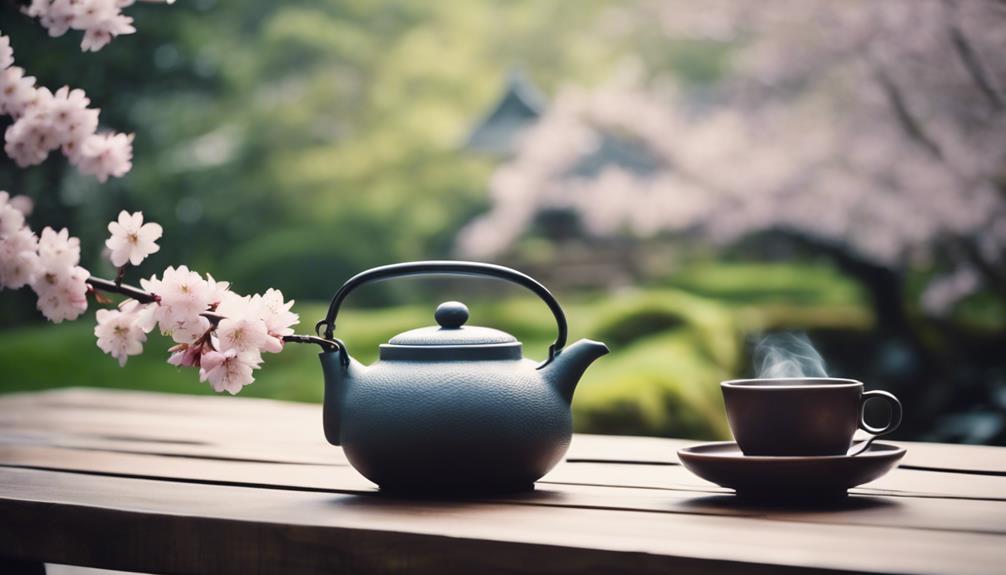
Green tea, packed with antioxidants and nutrients, has earned its reputation as a fountain of youth, boasting an impressive array of health benefits. It boosts cardiovascular health, aids in weight management, and supports the immune system. Additionally, it promotes relaxation, reduces stress levels, and alleviates anxiety and depression. Green tea's antioxidants also protect the skin from UV damage, reduce fine lines and wrinkles, and improve skin elasticity. Moreover, it enhances overall well-being, increases energy levels, and promotes mental clarity. As Dr. Weil notes, 'Green tea is a treasure trove of antioxidants.' Discover how to unleash its full potential and reveal the secrets to a longer, healthier life.
Key Takeaways
• Green tea's antioxidants and catechins boost cardiovascular health, reducing the risk of chronic diseases and promoting overall well-being.
• The L-theanine content in green tea reduces stress levels, alleviates anxiety and depression, and promotes relaxation and mental clarity.
• Green tea's caffeine and catechins enhance metabolism, aid in weight management, and improve insulin sensitivity, leading to a healthier and more energetic lifestyle.
• The antioxidants in green tea protect the skin from UV damage, reduce fine lines and wrinkles, and promote a natural glow, contributing to a more youthful appearance.
• Green tea's anti-inflammatory properties reduce the risk of chronic diseases, promote overall health, and contribute to a longer and healthier life, making it an elixir of longevity.
Health Benefits of Green Tea
Rich in antioxidants and nutrients, green tea offers a multitude of health benefits that contribute to its reputation as an elixir of longevity. It's packed with EGCG, catechins, vitamins, and minerals, which work synergistically to improve overall health.
Regular consumption of green tea has been shown to boost cardiovascular health, aid in weight management, and support the immune system. Its neuroprotective properties also reduce the risk of neurodegenerative diseases like Alzheimer's and Parkinson's.
Moreover, green tea's anti-inflammatory effects promote autophagy, cellular health, and longevity. By incorporating green tea into their daily routine, individuals can reap these benefits and take a significant step towards a healthier, longer life.
Mental and Emotional Well-being
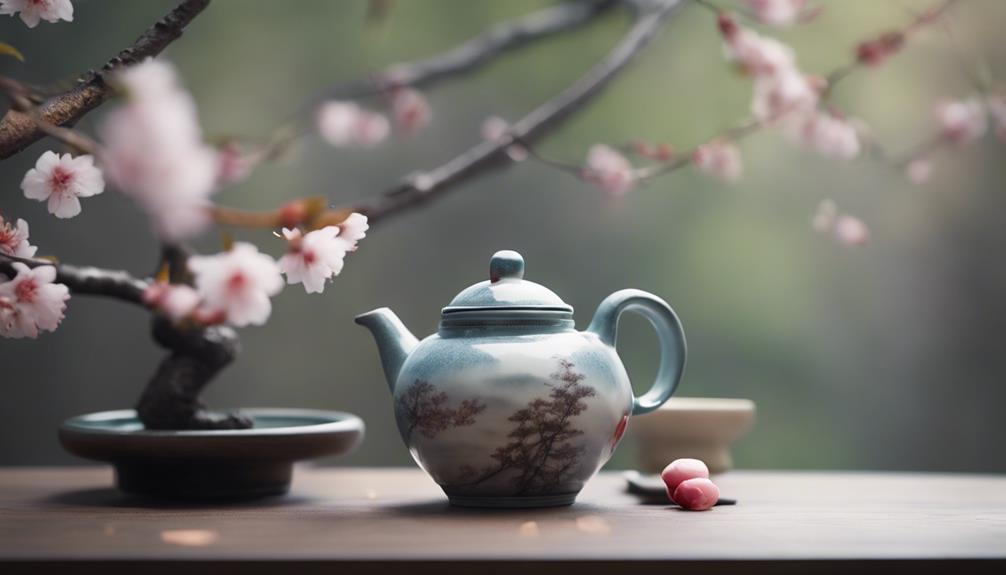
In addition, green tea's unique amino acid, L-theanine, promotes relaxation and reduces stress levels, allowing individuals to focus without feeling sedated. This natural calming effect helps alleviate anxiety and depression, leading to improved mental well-being.
The anti-inflammatory properties of green tea also reduce chronic inflammation, which is often linked to mental health disorders. Additionally, green tea enhances neurotransmitters like serotonin and dopamine, which regulate mood and cognitive function.
Regular consumption of green tea has been shown to improve overall mental clarity and emotional balance. By incorporating green tea into daily routines, individuals can experience enhanced mental and emotional well-being, ultimately contributing to a longer and healthier life.
Metabolism, Weight Management, and Detox
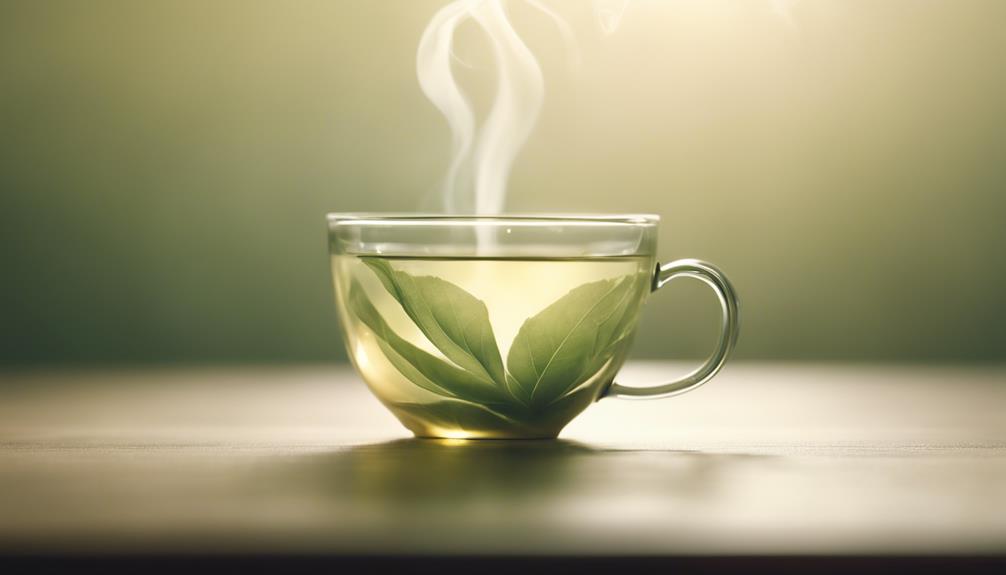
Caffeine and catechins in green tea work synergistically to boost metabolism, increasing thermogenic activity and aiding in weight management. This powerful combination helps the body burn fat more efficiently, making it an effective tool for those trying to lose weight or maintain weight loss.
Additionally, green tea has been shown to improve insulin sensitivity, which can help prevent or manage type 2 diabetes.
- Green tea supports fat oxidation, improving overall metabolic health.
- The antioxidants and polyphenols in green tea support liver function, aiding in detoxification and protecting the liver from damage caused by toxic substances.
- Regular consumption of green tea can lead to improved overall health and well-being, making it a valuable addition to a healthy lifestyle.
Skin Health and Longevity

One cup of green tea a day can keep the dermatologist away, as its antioxidants protect the skin from UV damage, reducing the appearance of fine lines and wrinkles.
Green tea's rich antioxidant profile shields the skin from environmental stressors, promoting a radiant and youthful complexion.
The antioxidants in green tea, particularly catechins, neutralize free radicals, which can cause skin damage and accelerate aging.
By incorporating green tea into their daily routine, individuals can enjoy improved skin elasticity, reduced inflammation, and a natural glow.
As a result, green tea has become a popular ingredient in skincare products and a staple in many beauty regimens.
Unlocking Green Tea's Potential
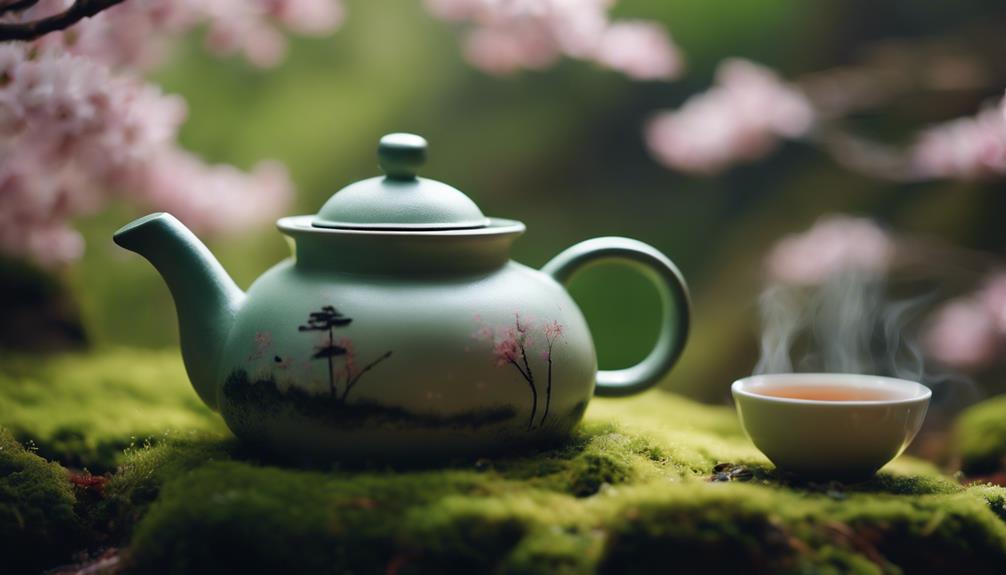
By incorporating green tea into their daily routine, individuals can access a wealth of benefits, from improved metabolism and mental clarity to enhanced overall well-being. Green tea's unique combination of antioxidants, vitamins, and minerals reveals a multitude of advantages, making it an ideal addition to a healthy lifestyle.
Regular consumption can lead to increased energy levels and enhanced mental focus.
Green tea's anti-inflammatory properties can reduce the risk of chronic diseases, promoting overall health and longevity.
Preparation and Consumption Tips

When brewing green tea, heating water to the recommended temperature of around 175°F is essential for bringing out the best flavor and nutritional benefits. Using high-quality green tea leaves, preferably loose-leaf, and looking for vibrant green leaves indicating quality is important. Experimenting with flavored green teas like jasmine, ginger, or mint can provide unique taste experiences while maintaining health benefits.
| Tip | Description | Benefit |
|---|---|---|
| Heat water correctly | 175°F for best flavor and nutrition | Brings out best flavor and benefits |
| Choose high-quality tea | Fresh, vibrant green leaves indicate quality | Ensures maximum health benefits |
| Experiment with flavors | Jasmine, ginger, or mint for unique tastes | Enhances enjoyment and variety |
Maximizing Green Tea's Benefits
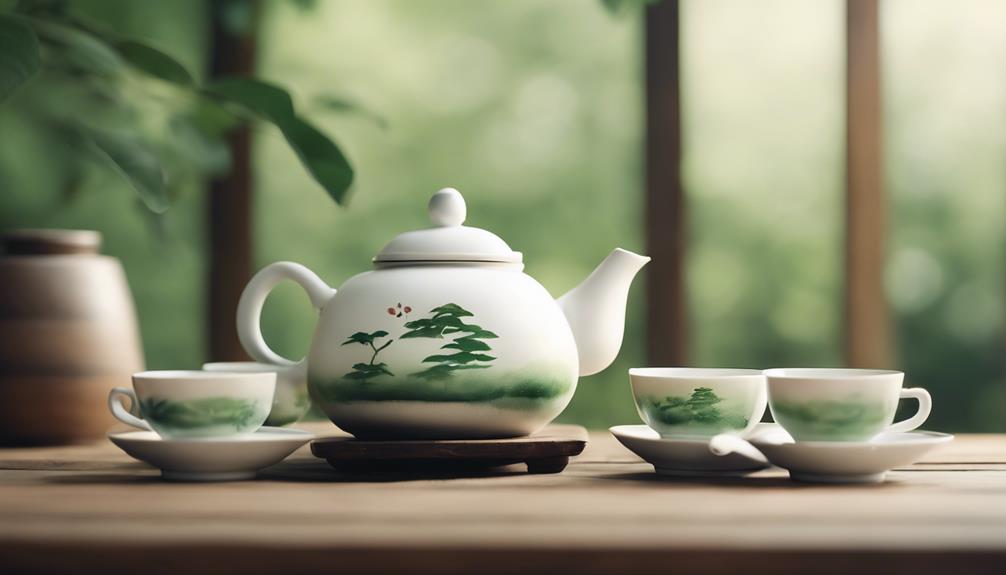
To maximize green tea's benefits, it's important to understand how to harness its full potential through consistent consumption, essential brewing, and strategic pairing with a healthy lifestyle. By doing so, individuals can realize the full range of advantages offered by green tea, from improved cardiovascular health to enhanced mental clarity.
To get the most out of green tea, consider the following:
- Start with high-quality leaves: Opt for fresh, organic green tea leaves to guarantee maximum nutrient retention and flavor.
- Brew it right: Heat water to 175°F and steep for 1-3 minutes to avoid bitterness and bring out the best balance of flavors.
- Make it a habit: Incorporate green tea into your daily routine, whether as a morning pick-me-up or an afternoon pick-me-up, to experience the cumulative benefits of regular consumption.
Frequently Asked Questions
Can Green Tea Be Consumed During Pregnancy or Breastfeeding?
Pregnant or breastfeeding women can consume green tea in moderation, but it's crucial to be mindful of caffeine intake. The American Pregnancy Association recommends limiting caffeine to 200mg or less per day, which is approximately one cup of green tea.
Excessive caffeine consumption can lead to miscarriage, growth restriction, and other complications. As a precaution, it's best to consult a healthcare provider before adding green tea to a prenatal or breastfeeding diet.
Does Green Tea Interact With Medications or Have Side Effects?
According to the National Institutes of Health, approximately 20% of adults in the United States take at least one medication daily, which raises concerns about potential interactions with green tea.
While green tea is generally considered safe, it can interact with certain medications, such as blood thinners, and may exacerbate side effects in people with certain health conditions.
As the Mayo Clinic advises, 'Green tea may decrease the effectiveness of certain medications, such as blood pressure medications, and may increase the risk of bleeding when taken with blood thinners.'
Can Green Tea Help Alleviate Symptoms of Menopause?
Green tea has been found to alleviate symptoms of menopause, particularly hot flashes and night sweats. The antioxidants and polyphenols in green tea help reduce inflammation, which contributes to menopausal symptoms.
Additionally, green tea's isoflavones, such as catechins, may mimic estrogen's effects, providing relief from menopausal symptoms. Studies suggest that green tea consumption can lead to a significant reduction in menopausal symptoms, improving overall quality of life for menopausal women.
Is It Better to Consume Green Tea Hot or Cold?
When it comes to consuming green tea, the temperature of the brew can impact its nutritional benefits. Research suggests that hot-brewed green tea may be more effective in extracting catechins, a key antioxidant, compared to cold-brewed tea.
However, cold-brewed green tea may be higher in antioxidants and lower in caffeine. Ultimately, the choice between hot and cold green tea depends on individual preferences and health goals, as both methods can provide unique benefits.
Can I Grow My Own Green Tea Plants at Home?
She can grow her own green tea plants at home, but it requires specific conditions. Green tea plants, Camellia sinensis, thrive in subtropical climates with mild winters and high humidity. They need acidic soil, partial shade, and consistent watering.
With proper care, the plants can be harvested in 3-5 years. According to the Tea Association of the USA, "green tea plants are relatively low-maintenance and can be grown in containers or directly in the ground."
Conclusion
To sum up, the profound benefits of green tea are undeniable, with its vast array of antioxidants, nutrients, and bioactive compounds working in harmony to revolutionize overall health and longevity.
By incorporating this ancient elixir into daily life, individuals can discover the secrets to a longer, healthier life, replete with boundless energy, mental clarity, and radiant skin.
As Dr. Weil, a renowned wellness expert, aptly notes, 'Green tea is the ultimate anti-aging beverage.'
By harnessing the extraordinary potential of green tea, individuals can transcend the boundaries of human health and experience a life of unparalleled vitality.
-

 Herbology4 months ago
Herbology4 months agoTop 5 Websites for 'A Journey Through Potions and Herbology' Free PDF
-

 Herbalism5 months ago
Herbalism5 months agoDoes Herbalism Actually Work?
-

 Herbology4 months ago
Herbology4 months agoHerbs Used in Iron Butte Herbology
-

 Herbology4 months ago
Herbology4 months agoExplore 'A Journey Through Potions and Herbology' by J.K. Rowling: Free PDF Download
-

 Bone Health5 months ago
Bone Health5 months agoHerbal Secrets Unleashed: Boost Bone Density
-
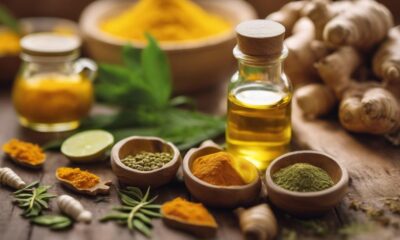
 Inflammation Management5 months ago
Inflammation Management5 months agoBest Natural Medicines for Joint Inflammation Relief
-

 Anti Aging5 months ago
Anti Aging5 months agoThe Immortal Herb: Unveiling Its Special Qualities
-

 Anti Aging5 months ago
Anti Aging5 months agoWhich Tea Increases Lifespan?















